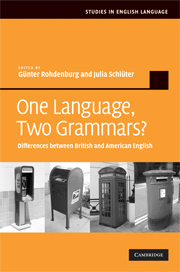Book contents
- Frontmatter
- Contents
- List of figures
- List of tables
- List of contributors
- Introduction
- 1 Colonial lag, colonial innovation or simply language change?
- 2 Compound verbs
- 3 The formation of the preterite and the past participle
- 4 Synthetic and analytic comparatives
- 5 Phonology and grammar
- 6 Prepositions and postpositions
- 7 Argument structure
- 8 Reflexive structures
- 9 Noun phrase modification
- 10 Nominal complements
- 11 Non-finite complements
- 12 The present perfect and the preterite
- 13 The revived subjunctive
- 14 The mandative subjunctive
- 15 The conditional subjunctive
- 16 Tag questions
- 17 The pragmatics of adverbs
- 18 How different are American and British English grammar? And how are they different?
- 19 New departures
- Bibliography
- Index
4 - Synthetic and analytic comparatives
Published online by Cambridge University Press: 03 July 2009
- Frontmatter
- Contents
- List of figures
- List of tables
- List of contributors
- Introduction
- 1 Colonial lag, colonial innovation or simply language change?
- 2 Compound verbs
- 3 The formation of the preterite and the past participle
- 4 Synthetic and analytic comparatives
- 5 Phonology and grammar
- 6 Prepositions and postpositions
- 7 Argument structure
- 8 Reflexive structures
- 9 Noun phrase modification
- 10 Nominal complements
- 11 Non-finite complements
- 12 The present perfect and the preterite
- 13 The revived subjunctive
- 14 The mandative subjunctive
- 15 The conditional subjunctive
- 16 Tag questions
- 17 The pragmatics of adverbs
- 18 How different are American and British English grammar? And how are they different?
- 19 New departures
- Bibliography
- Index
Summary
Introduction
The system of comparative formation exhibits two striking morphosyntactic differences between the British and American national standards. The first difference takes the form of an AmE – as opposed to BrE – lead in the use of analytic (more full) rather than synthetic (fuller) comparative forms. The second difference concerns the number of comparative forms of both the synthetic and the analytic kind: AmE newspaper data contain markedly fewer comparative forms than corresponding British material.
While both differences are remarkable in their own right, the question arises of what motivates the differing patterns of comparative formation in the two national standards. A tentative explanation will be pursued in terms of a postulated relation between cognitive complexity and style. We know that the use of analytic comparative forms increases in syntactically complex environments, a tendency subsumed under the notion of more-support (see Mondorf (to appear a)). This tendency is even more pronounced in AmE than in BrE and in informal than in formal styles. Thus, the British–American difference mirrors the formal–informal contrast: AmE and informal styles are generally more sensitive to complexity effects than BrE and formal styles.
The research introduced in the present chapter is predominantly based on newspaper data, the only exception being the British National Corpus (BNC). Table 4.1 provides a list of the corpora together with information on their approximate size.
- Type
- Chapter
- Information
- One Language, Two Grammars?Differences between British and American English, pp. 86 - 107Publisher: Cambridge University PressPrint publication year: 2009
- 29
- Cited by



